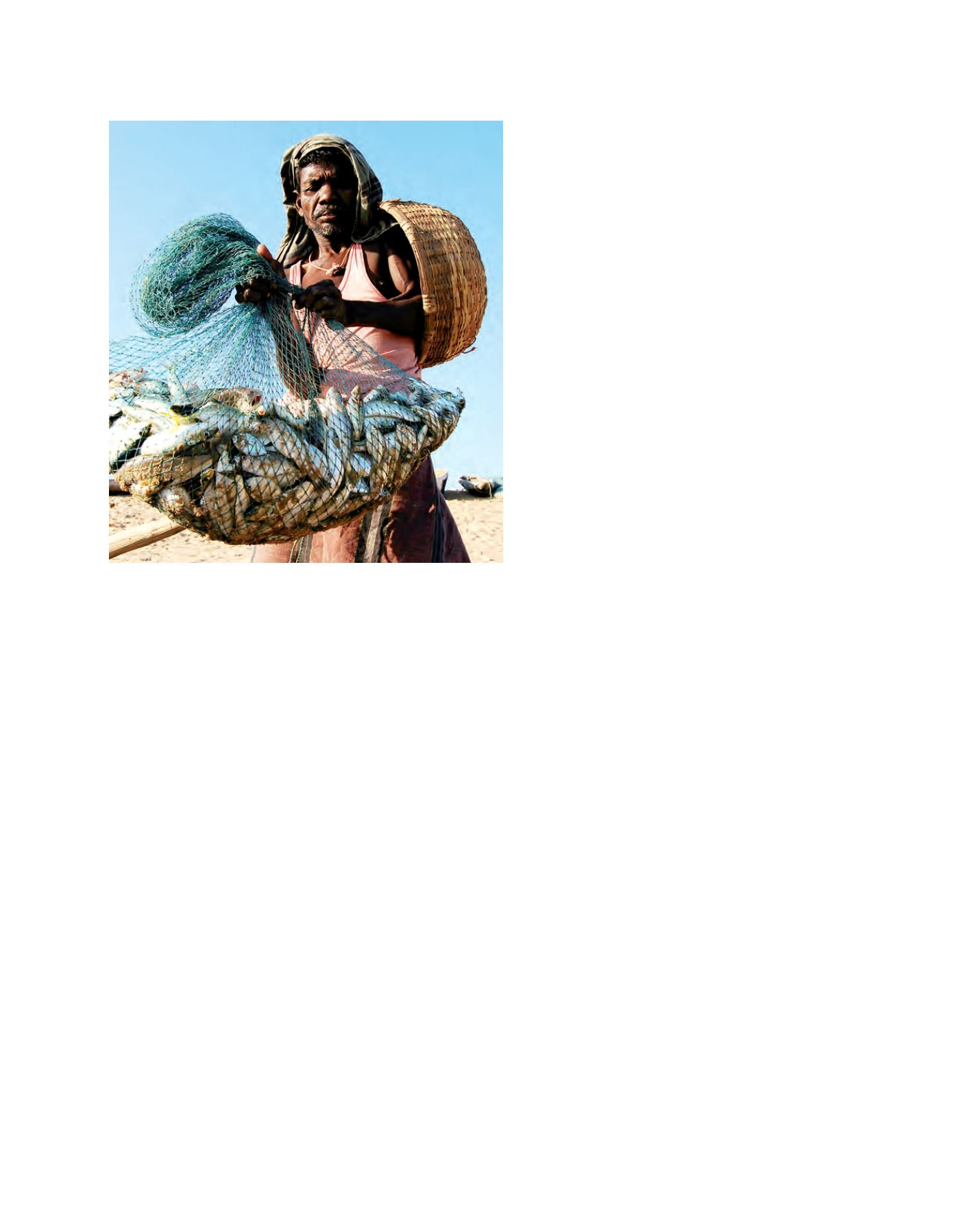

[
] 57
T
he
I
mpacts
and
I
mplications
of
C
limate
C
hange
and
V
ariability
cooler months – October to March, when mean SST is
27.5
o
C to 28
o
C.
7
False trevally,
Lactarius lactarius
, is an economically
and culturally important fish in India. It ranks as one
of the most preferred, high-quality fish in the Gulf of
Mannar region. Higher water temperatures and lower
rainfall because of global warming, however, have led
to a drastic decline in the numbers of this fish over the
last few years.
In the Indian seas, coral reefs are found in the Gulf
of Mannar, Gulf of Kutch, Palk Bay, Andaman Sea and
Lakshadweep Sea. Indian coral reefs have experienced
29 bleaching events since 1989. Intense bleaching
occurred in 1998 and 2002 when SST was higher than
the usual summer maxima.
Given the warning that reefs will not be able to sustain
catastrophic events more than three times a decade,
reef-building corals are likely to disappear as dominant
organisms on coral reefs between 2020 and 2040. Reefs
are likely to become remnants between 2030 and 2040
in the Lakshadweep Sea and between 2050 and 2060 in
other regions in the Indian seas.
8
On 30 June 2008, India released its first National
Action Plan on Climate Change outlining current
and future policies on climate mitigation and adapta-
tion. The plan identifies eight core ‘national missions’
running through 2017. The plan identifies measures
that promote development objectives and reap the
benefits of combating climate change.
Bangladesh
For Bangladesh, climate change may cause even more
of the floods, cyclones, storm surges and droughts
that have devastated it in the past. In September 2008,
the government developed the Bangladesh Climate
Change Strategy and Action Plan (BCCSAP), a ten-year
programme to build the capacity and resilience of the
country to meet the challenge of climate change over
the next 20 to 25 years.
BCCSAP claims that climate change will damage fresh-
water and marine fisheries in many ways – the spawning
of freshwater species will be impaired; water tempera-
tures in ponds and inland fisheries will go up; the ingress
of saline water inland further south will affect the aquatic
ecosystem and hit fish production; and turbulent weather
will impact on fishing livelihoods. It is critical, therefore,
that all potential impacts are identified and measures are
put in place to conduct the research and development of
management strategies.
Maldives
The Maldives is also particularly vulnerable to climate
change and the many scientific and technical assess-
ments of the region, which have taken place since
1987, have stressed the need for long-term adaptation
to climate change.
Fishing is at the heart of the Maldivian economy.
More than 20 per cent of the population depends on it.
It is a dominant employer with more than 15,000 fisher-
from a fleet of 59,000 mechanized craft, 76,000 motorized craft
and 105,000 non-motorized craft is about USD2.8 billion. Recent
scientific studies described below show that some commercially
viable maritime fish species in India are adapting to climate
change.
Small pelagics, especially the oil sardine, were at one time
confined to the Malabar upwelling zone along the southwest coast
of India, the area between latitude 8
o
N and 14
o
N and longitude 75
o
E
and 77
o
E, where the annual average SST ranges from 27 to 29
o
C.
Until 1985, almost the entire catch was from this area. In the last
two decades, however, the catches from latitude 14
o
N to 20
o
N are
increasing, indicating a positive correlation between the oil sardine
catch and SST.
5
Catches from this area contribute to about 15 per
cent of India’s entire oil sardine catch during 2006.
The Indian mackerel,
Rastrelliger kanagurta
, is also showing signs
of changing its habits. During the last two decades this species,
which normally occupies surface and sub-surface waters, has not
only moved north but has descended into deeper waters.
6
During
1985 to 1989, only two per cent of mackerel catch was from bottom
trawlers, pelagic gear such as drift gillnet accounted for the rest
of the catch. But from 2003 to 2007, bottom trawlers captured an
estimated 15 per cent of the mackerel catch.
The threadfin breams
Nemipterus japonicus
and
N mesoprion
are
distributed along the entire Indian coast at depths ranging from 10
to 100 metres. Data on the number of female spawners collected
every month off Chennai on the southeast coast of India from 1981
to 2004 indicate wide monthly fluctuations. The spawning season
used to occur in the warmer months from April to September, when
mean SST ranges from 29.0
o
C to 29.5
o
C. It now occurs in relatively
Over-exploited coastal resources and the adverse impacts of global warming are
making life difficult for traditional fishers in Tamil Nadu, India
Image: S Jayaraj
















